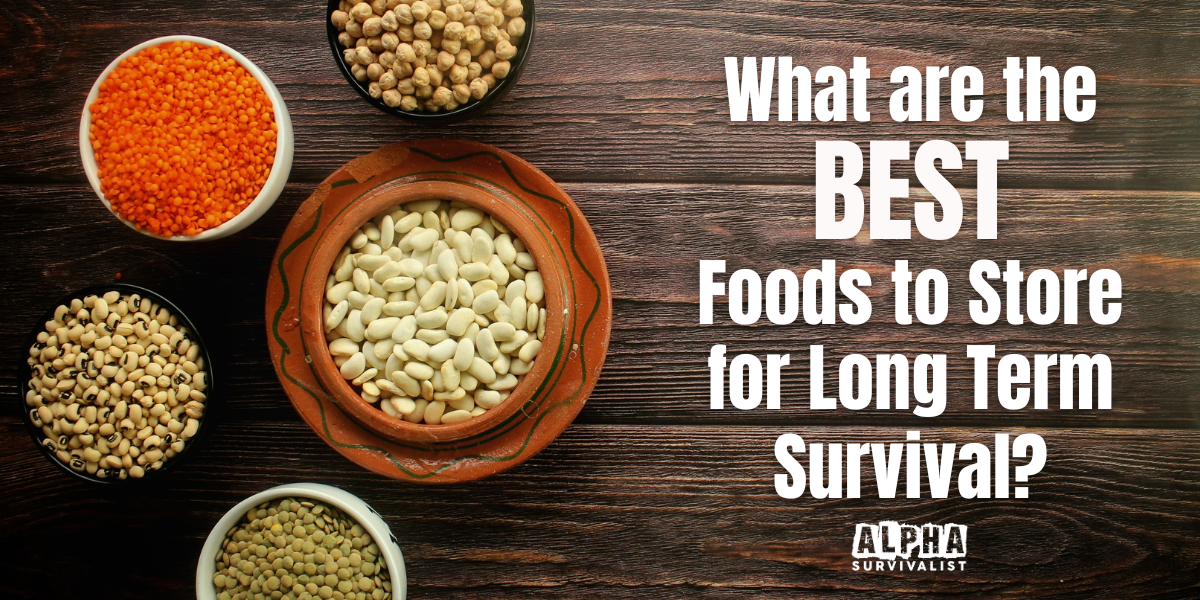What Foods are Best for Long Term Food Storage: Essential Stockpiling Tips
When considering long term food storage, one of the most critical aspects is ensuring that we have a reliable stockpile of food. The goal is to maintain a sufficient supply of nutrients and calories to sustain us through potentially challenging times, whether due to natural disasters or other unforeseen events. We focus on foods that have a long shelf life, require minimal preparation, and offer substantial nutritional value to meet our daily needs.
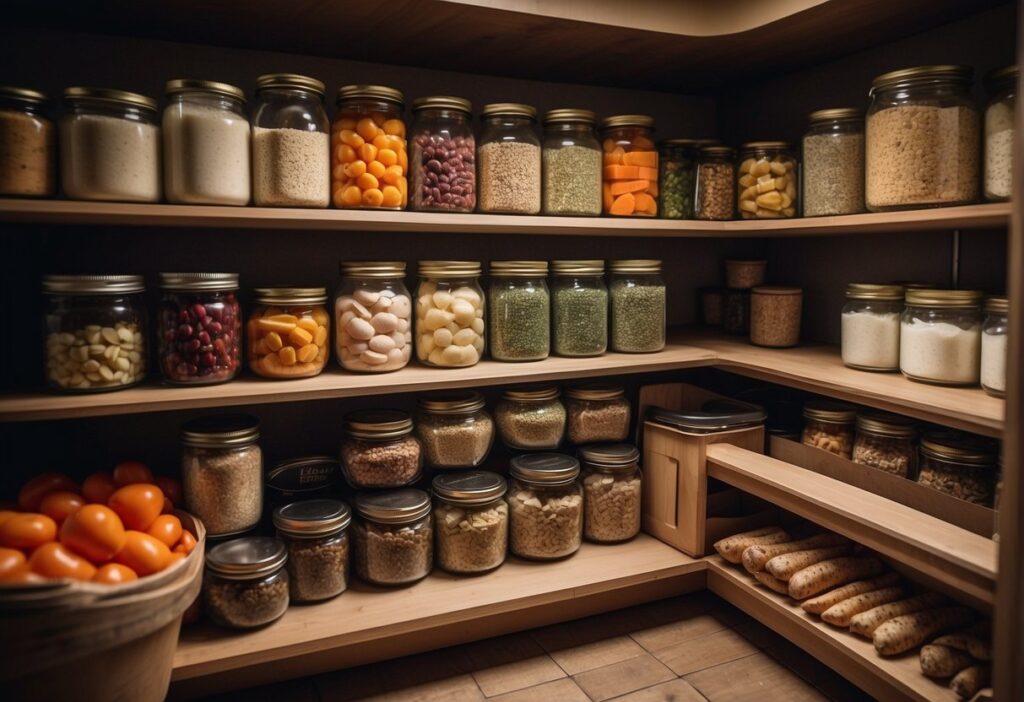
In creating our emergency food storage, it’s essential to select items that are non-perishable and can hold up over extended periods without refrigeration. We also need to consider the balance of macro nutrients – proteins, carbohydrates, and fats – alongside vitamins and minerals to ensure our diet remains as balanced as possible under the circumstances. Grains, legumes, canned goods, and certain dehydrated or freeze-dried foods are commonly prioritized due to their durability and ease of storage.
We understand that emergency food storage isn’t just about survival; it’s about resilience. Our stockpile is a carefully curated collection that accounts for the variances in shelf life, storage conditions, and versatility in meal preparation. It’s a strategic approach to ensure we’re prepared for any situation, providing us with peace of mind and the ability to face challenges with confidence.
Assessing Your Survival Food Needs
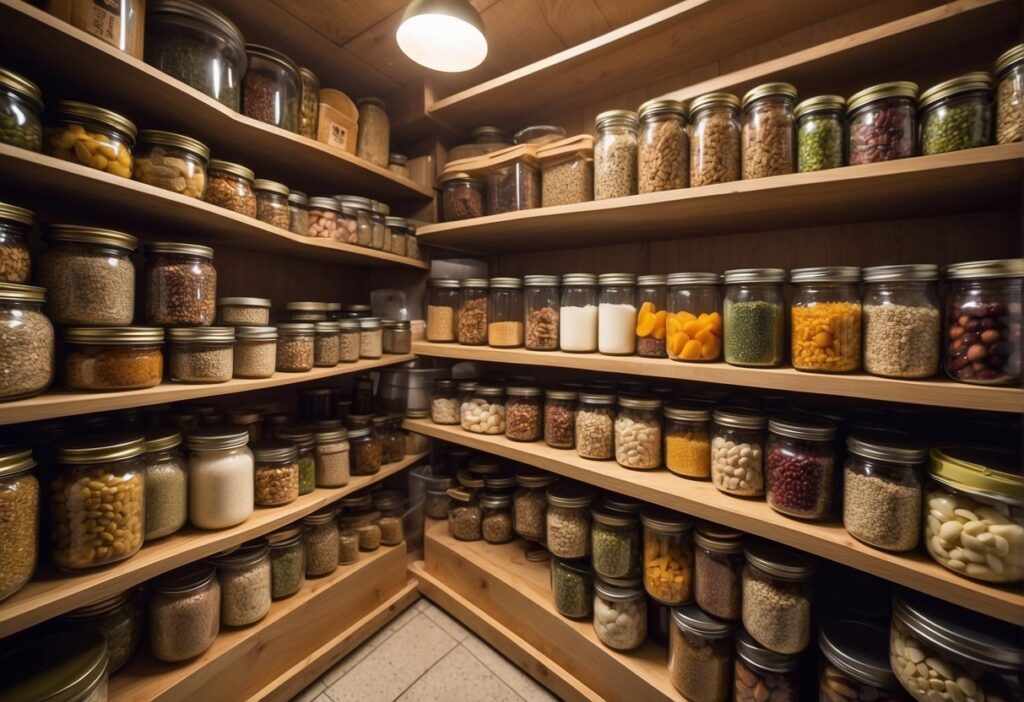
Before we stock our pantries for long-term survival, it’s crucial to identify what we need to sustain ourselves. This means knowing the calories required for survival and ensuring a balance of nutrition and variety in our food choices.
Determining Caloric Requirements
For Adults: We should aim to store foods that will meet, at a minimum, our basic caloric requirements. The average adult needs about 2,000 to 2,500 calories per day. However, individual needs can differ based on factors like age, gender, and physical activity levels. To calculate specific needs, we can use formulae like the Harris-Benedict equation or consult nutritionists.
For Families: When considering family needs, we multiply the number of people by the daily caloric intake for each. For a family of four, this could mean planning for 8,000 to 10,000 calories per day.
Balancing Nutrition and Variety
Nutrition: It’s not just about calories. Our bodies need a mix of proteins, fats, carbohydrates, vitamins, and minerals. In our pantry, we must store a diverse range of foods to cover all nutritional needs. For instance, beans and lentils are high in protein and fiber, while nuts and seeds provide essential fats.
Variety: Along with nutrition, we aim for variety to avoid “food fatigue.” It’s mentally and emotionally healthy to enjoy different tastes and textures. This means stockpiling a range of grains, legumes, dried fruits, and vegetables, ensuring that we cater to both our physiological and psychological well being.
Choosing Foods with Long Shelf Lives

When we talk about emergency preparedness, selecting foods that can last for years is crucial. It ensures our sustenance without frequent restocking.
Understanding Shelf Life Factors
Shelf life is influenced by several factors including storage conditions, processing methods, and the type of food. Temperature, humidity, and exposure to light all play a role in how long a food product can be safely consumed. Whole grains like rice and beans typically have longer shelf lives when stored in cool, dry conditions away from light. Properly sealed canned foods also offer extended shelf lives due to the absence of oxygen and preservation processes.
Best Foods for Long Term Food Storage
For long-term storage, we should focus on items that are less perishable and require minimal preparation. Here’s a breakdown of such foods:
- Rice: White rice has a shelf life of up to 30 years when stored properly.
- Beans: Dry beans can last up to 30 years, offering an excellent source of protein.
- Canned Foods: Vegetables, fruits, and meats are good for 1-5 years past the printed expiration date if the can remains in good condition, with no bulging, rust, or dents.
- Dried Foods: Items like jerky, powdered milk, and dehydrated fruits can last between 2-25 years. Keep them in airtight containers, away from light and heat.
These dried foods and other non-perishable items like wheat, lentils, and pasta are staples for long-term survival because of their longevity and nutritional value. Always monitor packaging integrity and environmental conditions to maintain the quality and safety of our food storage.
Essentials of Water Storage
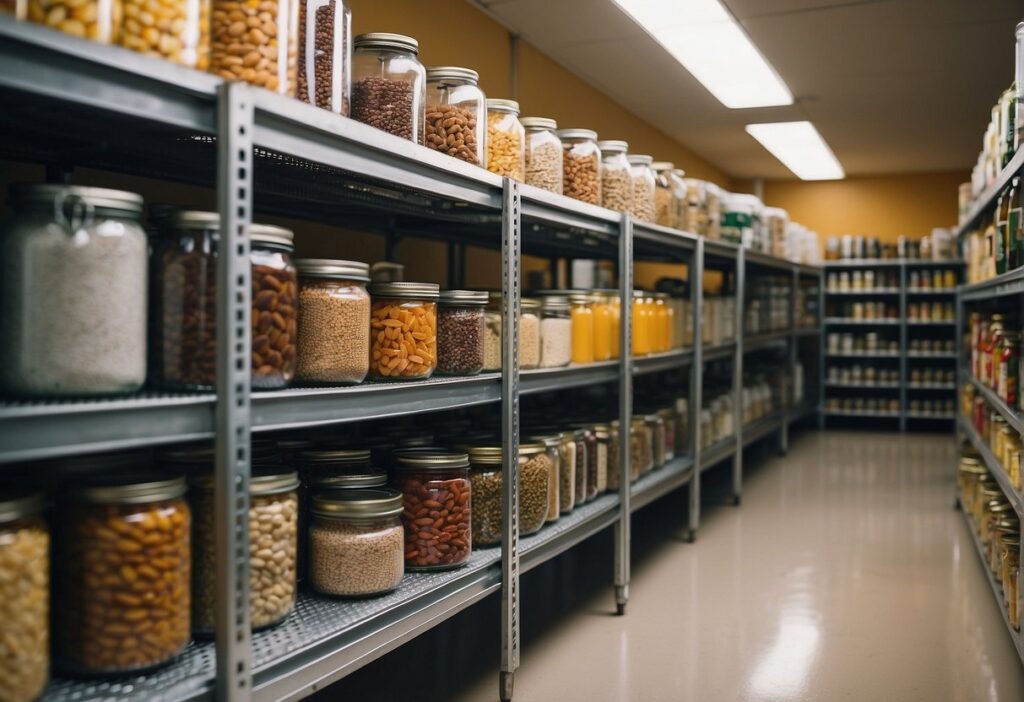
In preparing for long-term survival, we recognize that water is paramount. Ensuring a safe, sustainable supply can mean the difference between thriving and facing serious dehydration issues. We’ll cover how to store water safely and how to determine the amount you need to store.
Safe Water Storage Practices
We should use clean, food-grade storage containers specifically designed for water to prevent contamination. These containers must be sealed tightly and stored in a cool, dark place to inhibit bacterial growth. It’s critical to treat the water with chlorine bleach or commercial water preservatives to ensure its potability over time. If we’re repurposing containers, they need to be thoroughly sanitized and rinsed.
Calculating Adequate Water Supply
We need to calculate our water needs to ensure an adequate supply. As a baseline, each person requires approximately one gallon per day for drinking and sanitation. To calculate, simply multiply one gallon by the number of people and the number of days you’re planning to cover. A family of four aiming for a one-month supply would need:
- Daily needs: 4 people x 1 gallon/person/day = 4 gallons/day
- Monthly needs: 4 gallons/day x 30 days = 120 gallons
Adjust the quantities to suit specific medical needs or climatic conditions. Remember, in emergencies, regular water sources can become compromised, so our calculations must factor in these potential risks.
Storing Protein and Dairy Alternatives

In preparing for long-term survival, we ensure our food storage includes protein and dairy alternatives that are not only nutrient-rich but have a long shelf life. Let’s explore how to diversify these food sources and identify shelf-stable dairy options that can sustain us over extended periods.
Diversifying Protein Sources
Protein is crucial for maintaining muscle and overall health. We consider various sources to create a well-rounded reserve. Canned tuna is a staple due to its long shelf-life and high protein content; a can typically provides around 20 grams of protein. Additionally, nuts and lentils are excellent protein-rich options that are dry, compact, and store well. A cup of lentils has approximately 18 grams of protein, making it a powerhouse for sustenance.
- Canned tuna, salmon, chicken, or turkey: Long shelf life and high protein content.
- Nuts (like almonds, walnuts, etc.): Rich in essential fats along with protein; easily stored.
- Lentils: High in protein, fiber, and other nutrients; optimal for dry storage.
Shelf-Stable Dairy Products
We acknowledge dairy’s importance in a balanced diet. However, fresh dairy products have a limited shelf life. Our solution is powdered milk, which can be stored for years and reconstituted with water. It’s an excellent source of calcium and vitamin D. While not a direct dairy product, protein-packed seeds can also be a dairy substitute in many recipes, adding nutritional variety to our pantry.
- Powdered milk: Long shelf-life; reconstitutes into a dairy source for multiple uses.
- Non-dairy protein-boosters: Consider seeds, like sunflower or pumpkin, as high-protein add-ins.
Packing and Preserving Food for Long Term Food Storage
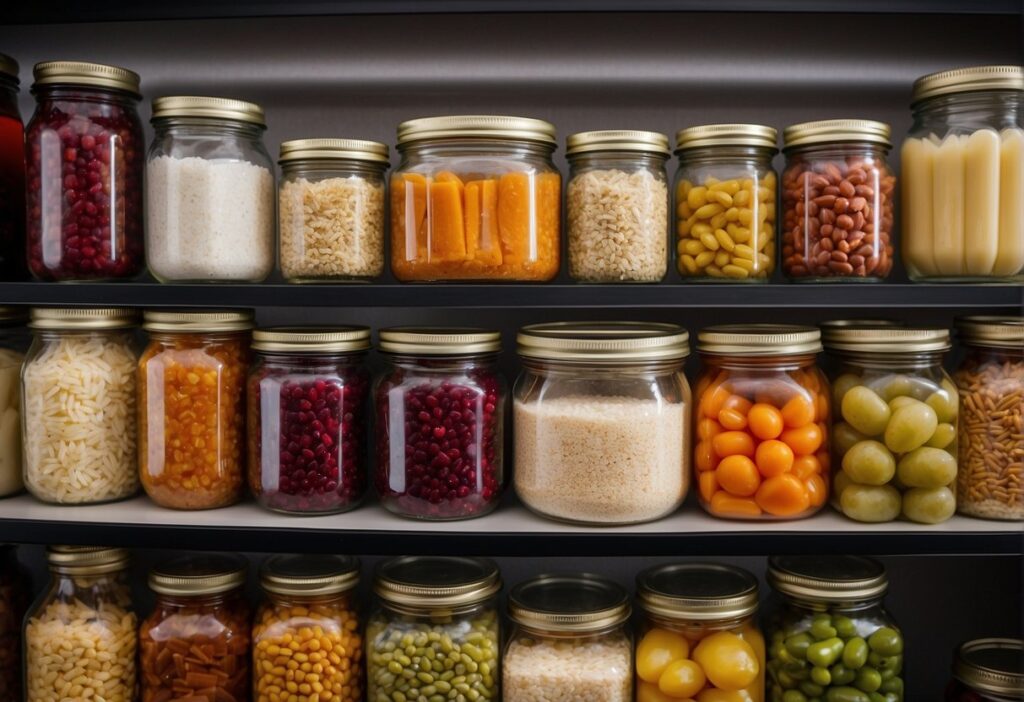
When thinking about long-term food storage, we need robust methods that protect against spoilage and maintain nutritional value. Two proven techniques we rely on are the use of Mylar bags with oxygen absorbers and the traditional methods of canning and dehydrating our homegrown produce. Proper execution of these methods not only extends the shelf life of food but also keeps our sustenance safe and palatable.
Using Mylar Bags and Oxygen Absorbers
Mylar bags have become indispensable in our food preservation efforts due to their exceptional barrier properties. Here’s how we go about using them:
- Filling: We fill Mylar bags with dry goods such as rice, beans, or pasta.
- Sealing: We carefully expel as much air as possible before sealing with a heat sealer.
- Protection: To significantly hinder oxidation, we add the right size of oxygen absorbers inside before sealing.
Our guidance on oxygen absorbers: For a gallon of product, we use a 300-500cc oxygen absorber. This method effectively extends the shelf life of dry goods to decades when stored in cool, dark conditions.
Canning and Dehydrating Homegrown Produce
Our next step is to preserve the bounty from our gardens using canning and dehydrating.
- Canning:
- Preparation: We wash and prep our produce, ensuring we have all necessary materials sterilized and ready.
- Processing: We can using either the water bath method for high-acid foods or a pressure canner for low-acid foods.
- Storage: Then, we store the jars in a cool, dark place, check them for proper seals and any signs of spoilage regularly.
- Dehydrating:
- Preparation: We slice produce uniformly for even drying.
- Drying: We use a dehydrator or occasionally an oven at low temperatures to remove moisture content from the food.
- Packaging: The dried goods are then stored in airtight containers, often with oxygen absorbers added for further shelf life enhancement.
By employing these methods, we ensure our dehydrated and canned foods are nutritious, safe, and ready for future use.
Emergency Food Preparation Methods

In preparing for situations where traditional resources may be scarce, we focus on reliable methods to prepare and preserve food. We consider the absence of electricity and the essentials of meal planning during emergencies.
Cooking Without Electricity
When electricity is not an option, we can rely on alternatives such as solar ovens and gas stoves. We use solar ovens when there is ample sunlight, particularly advantageous during long, bright summer days. In contrast, portable gas stoves are essential during winter when sunlight is limited. Both methods are practical and can preserve food efficiently without the need for electrical power.
We also consider no-cook foods in our strategy. These are items that are either ready to eat or require only the addition of water. For instance:
- Canned beans
- Dehydrated fruits and vegetables
- Nuts and seeds
- Crackers and cereals
It’s important to keep these foods stocked as they are both convenient and less reliant on the availability of light or fire to prepare.
Simple Meal Planning for Crises
Our meal planning revolves around simplicity and effectiveness. During crises, we focus on minimizing effort while maximizing nutrition. We create a balanced meal plan that includes:
- Proteins: Canned meats, legumes, and nut butter
- Carbs: Rice, pasta, and oats
- Fats: Oils and seeds
- Vitamins & Minerals: Canned fruits and vegetables
To ensure longevity, we utilize vacuum sealing and desiccants to remove air and moisture, key factors in food spoilage. Our plans always include preserve food with long shelf lives to minimize waste and replenishment frequency. We prepare these foods using manual tools like can openers and hand grinders to reduce our dependency on electricity. This approach keeps us ready for any eventualities while ensuring a balanced diet.
Building a Balanced Food Stockpile
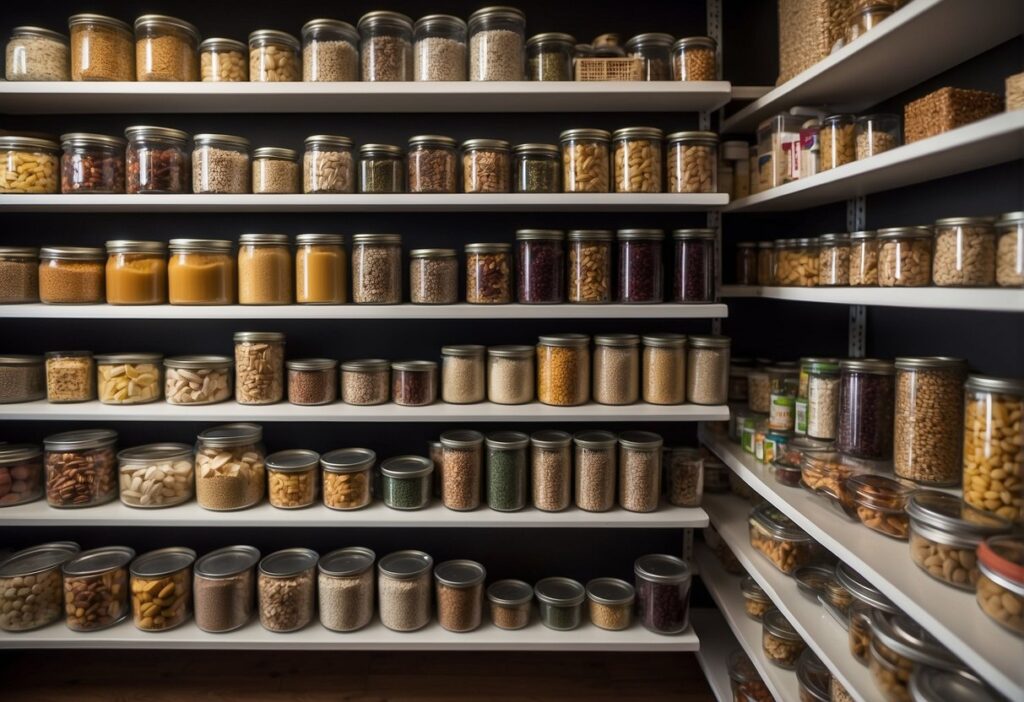
When we talk about long-term survival, ensuring a well-rounded stockpile is critical. This means balancing nutrition, shelf life, and variety to secure sustenance for extended periods.
Incorporating Fruits and Vegetables
Fruits and vegetables are integral to maintaining a healthy diet. However, fresh produce has a limited shelf life, so we focus on forms that preserve their nutritional value over time.
For vegetables, we seek out options like canned beans that offer a great source of protein and fiber. Canned vegetables also provide essential nutrients, although we make sure to choose low-sodium varieties whenever possible.
Our stockpile also includes a variety of dried fruits, such as apples, apricots, and oranges. These are especially valuable as they retain much of their vitamin content and can be re-hydrated if necessary. Dried fruits afford us vital vitamins and a natural source of sugar for energy.
Incorporating grains like rice and pasta allows us to create hearty meals that are both filling and versatile. Grains store well and can be a base for numerous dishes. Coupled with beans or other proteins, they form complete meals that are both satisfying and nutritious.
Lastly, we ensure a good supply of canned food items, including fruits and vegetables, which are excellent for their long shelf life and ease of preparation. With a balance of these food groups in our stockpile, we set ourselves up for a sustainable food supply.
Considerations for Special Diets
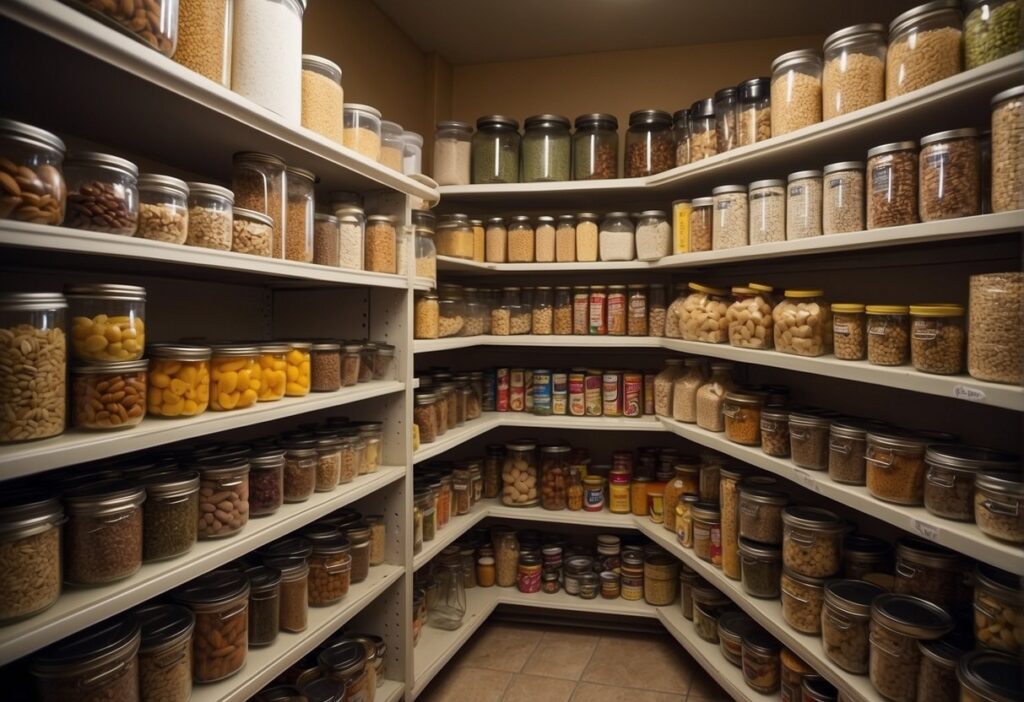
When preparing for long-term survival, we must ensure that our food stockpile caters to various dietary requirements. It’s crucial to account for individual needs, such as allergies and the specific nutritional requirements of children and elders.
Accounting for Allergies and Intolerances
For those of us with food allergies or intolerances, we need to store foods that are safe to consume.
Dried fruits and nuts are nutritious options, but we must verify they are free from cross-contamination if we have nut allergies. Instead, we can opt for individually packaged items that are labeled allergen-free.
Keeping a supply of salt is also vital as it’s a preservative that’s generally safe for those with dietary restrictions, and it can enhance the flavor of various stored foods in our stockpile.
Adapting Stockpile for Children and Elders
Children and elders have unique nutritional needs, so we need to take a thoughtful approach to our survival food storage. For the young ones, it’s important to store foods rich in nutrients needed for growth, like dried fruit which is packed with vitamins. For elders, we should store foods with softer textures that are easy to chew and digest, such as oatmeal or powdered meals. We should also ensure the presence of healthy fats in our stockpile, considering items like oil-packed canned fish, which offer essential fatty acids beneficial for all ages.

